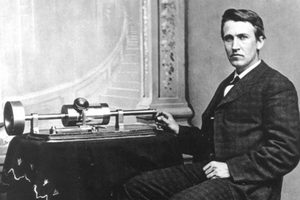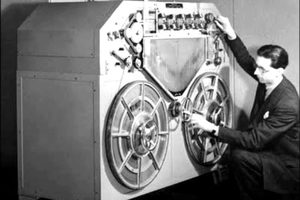- in Gear , Microphones , Production , Recording by Bobby Owsinski
Excellent Pictures That Illustrate The 4 Eras Of Audio Recording

Thomas Edison started it all.
Sometimes a picture is worth a thousand words and these 4 pictures tell you all you need to know about how audio recording has evolved over the years. There are really 4 eras to audio recording – the acoustic era, the electronic era, the magnetic era, and the digital era.
Let’s look at some great pictures that illustrate each one, starting with the one on the left. This features Thomas Edison with his original phonograph using tin foil wrapped around a cylinder. It all started here.

Recording The Victor Orchestra
The Acoustic Era: In order to capture audio during the acoustic era, basically the same gear was used as for playback, only in reverse. Here we see the Victor Orchestra being picked up by the recording horn at the Victor Talking Machine Company studio during an early acoustical recording session. (Library of Congress)

The first tape recorder using steel tape
The Electronic Era: Developed in 1931 by British film maker Louis Blattner, the Blattnerphone was the first device that was able to record audio on thin magnetic steel tape. It was good enough for voice, but as you could imagine, didn’t have the bandwidth for music. Still, it was a breakthrough and a glimpse of what was soon to come. Also, you made your edits by soldering the steel tape together. Don’t burn your fingers!

Les Paul’s DIY 8 track
The Magnetic Era: Guitarist and inventor Les Paul shows off his home-made 8 track tape machine, the first multi-track capable of overdubbing.

Dr. Tom Stockham and his Soundstream digital recorder
The Digital Era: Dr. Tom Stockham pioneered digital recording with his 4 track Soundstream digital recorder in 1977. It recorded at 50kHz and 16 bits and was based on a Honeywell computer instrumentation platform and A to D and D to A converters by Soundstream. A total of 18 were manufactured.
There are some additional excellent pictures of each era in this Mixmag article.

